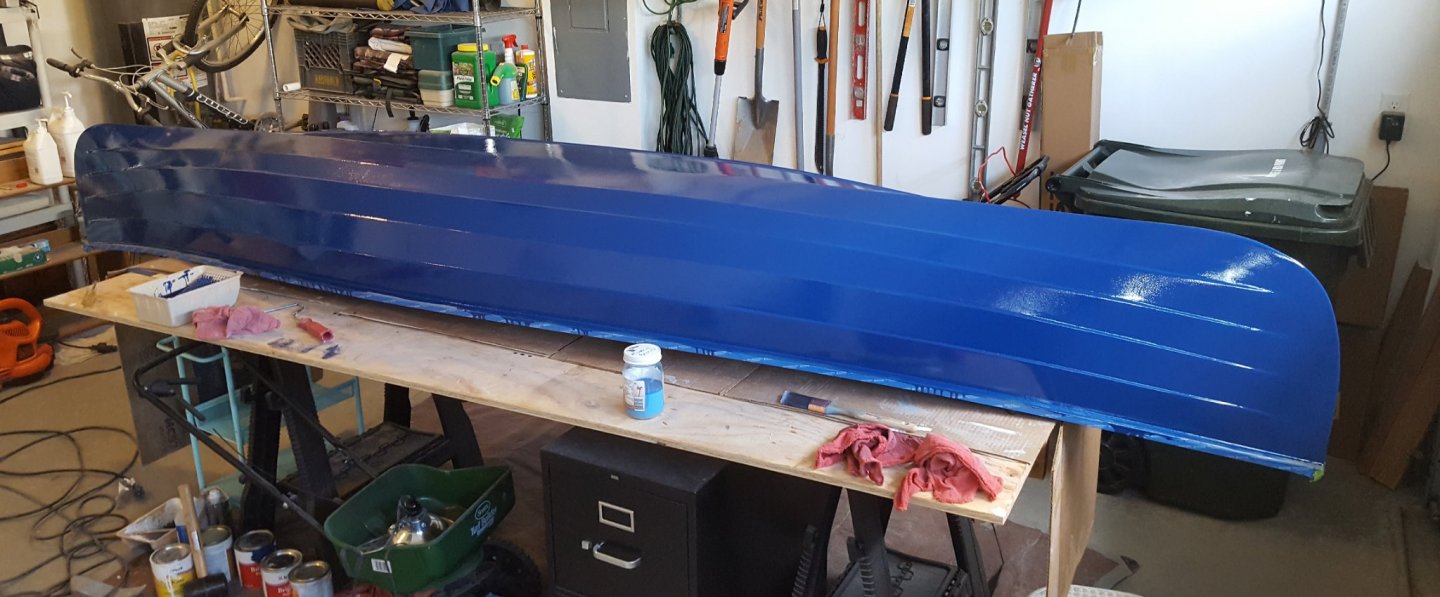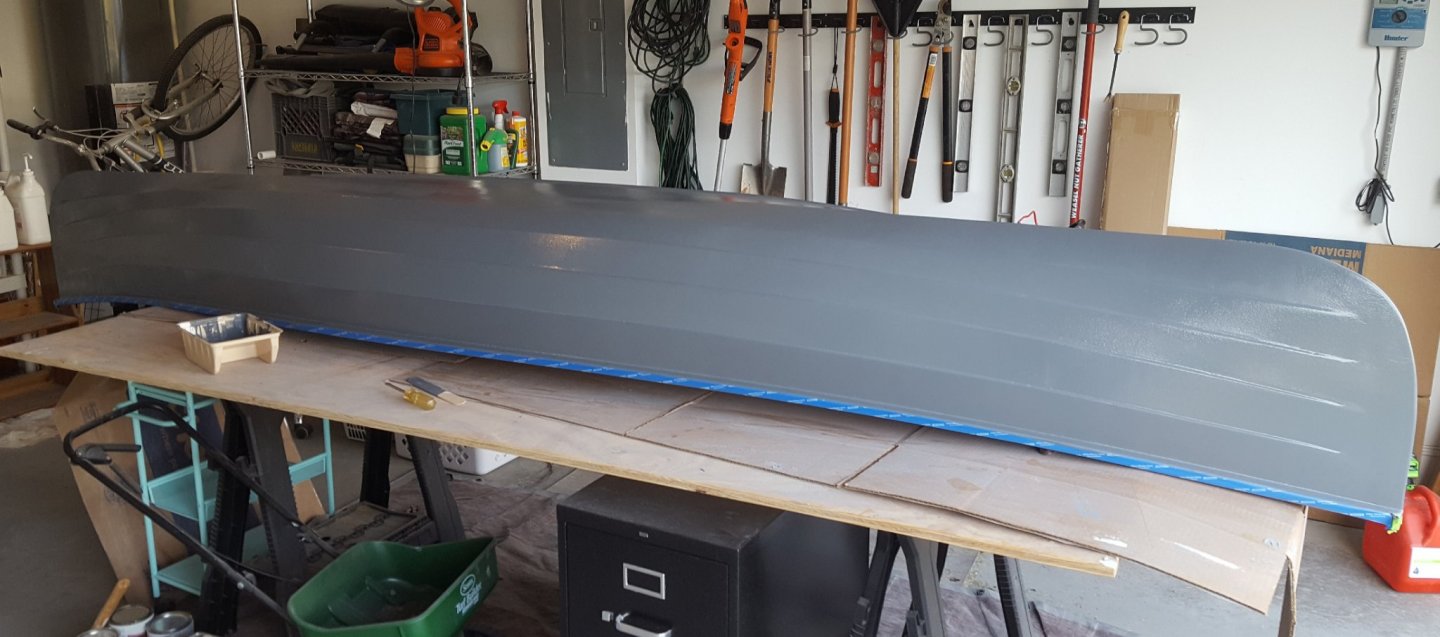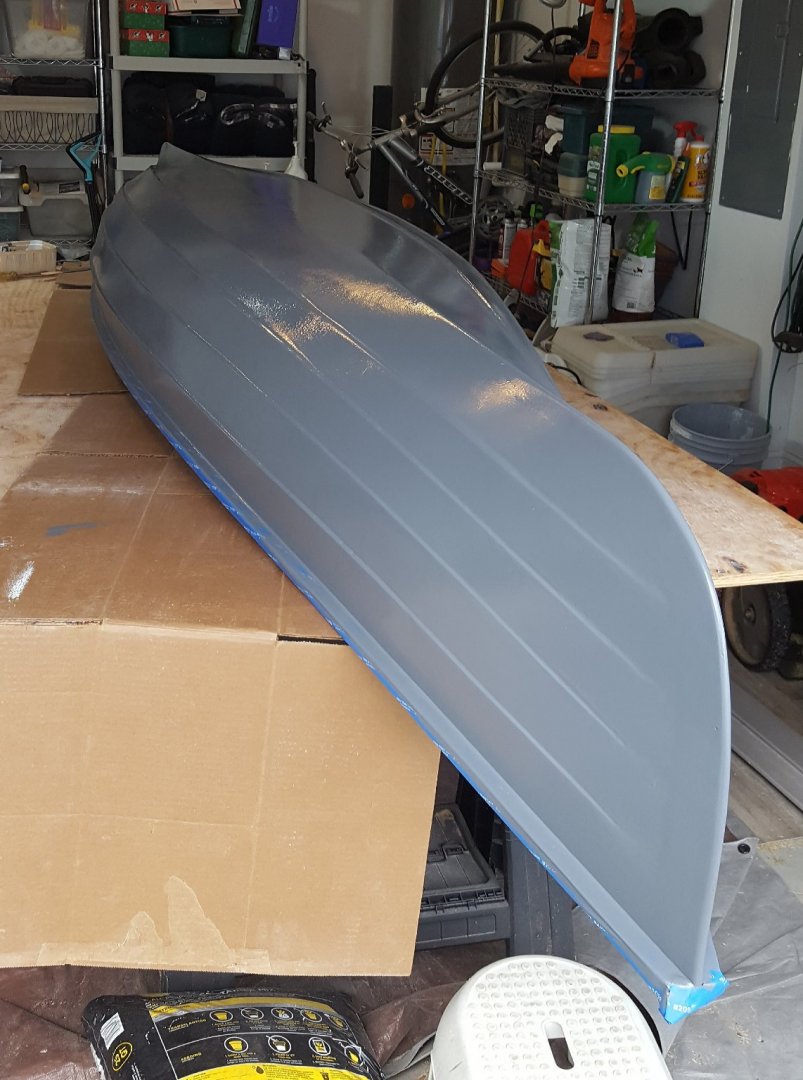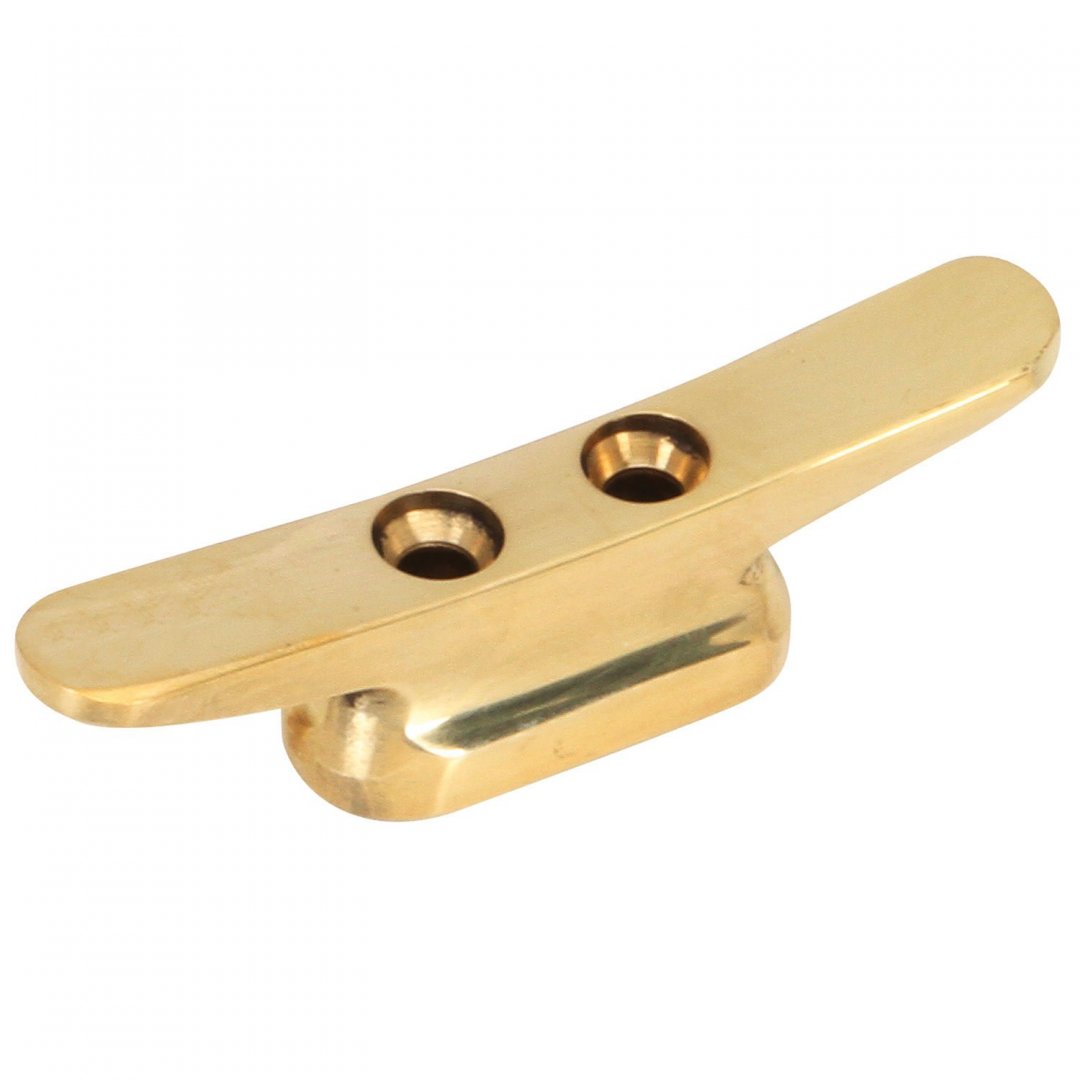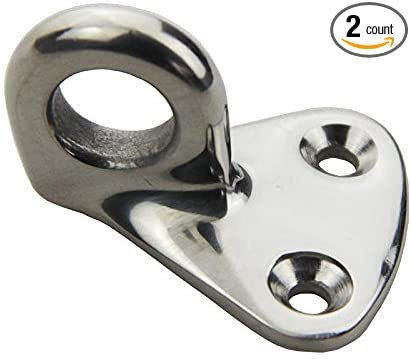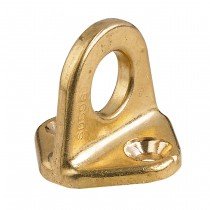-
Posts
10,551 -
Joined
-
Last visited
Content Type
Profiles
Forums
Gallery
Events
Everything posted by ccoyle
-
Okay, this is a question for the experts on polyurethane paint out there. I finished scuffing exterior coat #2 last night in preparation for coat #3, and I became mildly alarmed at how easy it is to scuff the paint with 400-grit sandpaper. So, thinking ahead to bumping into rocks, brush, docks, and boat ramps, how durable is marine-grade polyurethane actually supposed to be? It doesn't say anything on the can, but is there a "completely cured" time in excess of the touch-dry/sand-dry times? Thanks!
-
Okay, now we're cookin'! This is the first coat of exterior top color. It's a polyurethane marine paint, so it dries like a hard shell and will add a little something to the hull's integrity. The paint is rolled on with a foam roller, and then I tipped out the bubbles with a soft, angled brush. I decided I didn't like the recommended disposable foam brushes for the latter task -- the regular brush gives me much better control. There are also two coats of interior top color already done, though obviously not visible in this image. 😉 Both interior and exterior will get a minimum of three coats, and the paint coverage has been good, so a fourth is definitely a possibility. Sand -- paint -- wait -- repeat. 😜
-
Welcome! Great work on your model!
-

Hello from sunny Southern California
ccoyle replied to boatsNbeers's topic in New member Introductions
Welcome aboard, Dan. I have always like the looks of Lilla Dan -- hope you do well with her when you get around to it. If you are near Fullerton, check out the Ship Modelers Association, one of the largest local clubs in the country and an NRG partner. I was a member back in my SoCal days. Cheers! -
That is indeed looking very, very nice. Agree, but I do like the fact that the box art version shows an out-of-the-box build, which is what box art should be. The customer should be able to see exactly what he is getting for his money. Sadly, this is not the case for all manufacturers everywhere, as we are all well aware.
- 1,039 replies
-
- ballahoo
- caldercraft
-
(and 2 more)
Tagged with:
-
I did the second coat of interior primer last night and rolled on the third during lunchtime today (working from home for a couple of days). It is evident to me that a certain amount of unevenness will remain on the finished product, but I think that choosing a light interior color was a good decision. At least with the primer, the warts are not extremely obvious at normal viewing distances. I will begin applying the interior top color tomorrow. Today's photo shows the second coat of interior primer prior to today's work.
-
Wow. That barely qualifies as a "kit." It will be interesting to see if you can work some magic with this. Cheers!
- 22 replies
-
- Horizon
- Chesapeake Bay Skipjack
-
(and 1 more)
Tagged with:
-
Stein, that is a fantastic model! Please, please, please create an entry for her in the gallery!
-
The idea is that the primer fills in low spots; sanding knocks off the high spots, thus (hopefully) creating a more level surface, i.e. smoother. I still have a few dimples in the seams that I'm not completely happy with. These are spots where the epoxy oozed through to the inside, creating tiny puckers on the outside. They're still water-tight, and they won't be immediately apparent when the boat is upright, but they still bug me. I only have a small amount of the gray primer left, but I'm thinking I'd like to do a fourth coat. I have some foam rollers, so I may give the 4th coat a go with one of them -- it should produce greater coverage. I have been sanding with 120 grit between coats until now, but I will go down to 220 between these last coats. But before that I plan on flipping the boat over and working on the inside. Now that I've seen just how much "filling" the primer will do, I know there's no hope of getting a perfectly smooth finish on the interior (cuz of my amateurish epoxy and fiberglass work), so I won't fret too much about it and will just focus on gittin' her done. P.S. I casually mentioned to The Admiral the other day that now that I had the basic boat-building skills down pat, I needed to add another boat to my fleet, one that could take a small outboard motor. She gave me a long-winded reply that translates as "no." I wasn't too perturbed, because I know we don't have the room for a second boat anyway. 😉
-
Welcome, nehemiah. Those are all good kits you mentioned. Polotsk will have the simplest rig of the three, being a topsail schooner rather than brig-rigged. Granado and Flirt are both Chris Watton designs, and Flirt is much newer, so that kit will include all of Chris's latest design innovations. But you can't overlook personal preference, i.e. which ship do you best like the looks of? Liking your kit selection goes a long way toward build motivation. Cheers!
-
Third coat of primer. My paddle and car-top soft racks arrived today. I had quite the time settling on a paddle, but ultimately narrowed the decision to an angler's paddle from either Bending Branches or Best Marine. They were essentially the same paddle -- same design, same length, both two part paddles, both companies have great customer service. I finally opted for the Best Marine paddle, because it has a carbon fiber shaft rather than an aluminum shaft, so it is about 4 oz lighter. Most carbon fiber paddles cost at least $50 more, so I was a bit worried about that, but the company's reviews everywhere were good, so I took the gamble. BTW, did you know that high-end paddles can sell for over $500? Yikes! Now to wait for paint to dry -- again.
-
The easiest and most beneficial way to dispose of a large number of tools and supplies is to donate them to a local modeling club. The club can then auction the items off to raise funds, and your father's supplies will end up in the hands of people who can appreciate and use them. To find your nearest club, check here.
-
I love the Corsair, and Baa Baa Blacksheep was one of my favorite shows as a kid (even wrote a letter of protest to NBC when they announced its cancellation -- received a glossy, Robert Conrad-autographed B&W print of the cast as a thank-you gift). The few available card models of the F4U aren't particularly detailed. I'm waiting for Halinski to publish one, then I will be all over it.
-
Thanks, Gary. I have actually been pondering most of the points you bring up. I have purchased a set of soft, roof-top pads, designed for cars without roof racks. The pads fasten through the passenger compartment and have the built-in straps that go over the canoe. Because of the canoe's length, it will need tie-downs at both bow and stern (also provided in the kit). Being a pack canoe, i.e. the paddler sits on the floor, the only thwart is the one to which the seat back attaches. I have seen many pictures of antique canoes that have hardware attached ("canoe jewelry"), and I am also well aware of the limited options for attachment -- I do not wish to ding my car top or elbows or knees on any poorly-placed hardware that sticks out where it shouldn't. But I have time to meditate on all this. Oh, and I have seen it recommended that soft carriers not be used at speeds above 55 mph (88 kph), which I don't see as an issue for the foreseeable future -- plenty of water to check out locally without needing to hop on the interstate. Thanks for checking in!
-
I'm trying to keep in mind the old adage about the perfect being the enemy of the good. Mostly I just want a functional craft that will not result in my untimely death.😝 But, I do want it to look half-way decent, and I tell myself that a smoother hull will reduce drag and likely give me another 0.001 m/s of speed. 😋 Still, I don't really want to fork out more $$$ for primer, so it will be three coats max, if I can make it last that long.
-
Personally, I have a thing for pre-Dreadnoughts, so Condorcet gets my vote.
-
Whilst browsing around today, I came across a YouTuber who just happens to be at the same point of constructing a Sassafras 12 as I am. He's documenting his build in a series of videos. I found his video on priming very helpful. I'm reluctant to watch any of the earlier videos, for fear I might discover some fault in my methods that I probably don't want to know about at this point. 😬
-
Fat chance! I've been thinking ahead to mooring options. When I finally get around to car-topping this thing, I will need anchoring points at both the bow and stern. Perhaps horn cleats ... ... or maybe pad eyes. These would also serve as points for attaching a painter or anchor line. Also thinking about where to attach them. Decisions, decisions.
About us
Modelshipworld - Advancing Ship Modeling through Research
SSL Secured
Your security is important for us so this Website is SSL-Secured
NRG Mailing Address
Nautical Research Guild
237 South Lincoln Street
Westmont IL, 60559-1917
Model Ship World ® and the MSW logo are Registered Trademarks, and belong to the Nautical Research Guild (United States Patent and Trademark Office: No. 6,929,264 & No. 6,929,274, registered Dec. 20, 2022)
Helpful Links
About the NRG
If you enjoy building ship models that are historically accurate as well as beautiful, then The Nautical Research Guild (NRG) is just right for you.
The Guild is a non-profit educational organization whose mission is to “Advance Ship Modeling Through Research”. We provide support to our members in their efforts to raise the quality of their model ships.
The Nautical Research Guild has published our world-renowned quarterly magazine, The Nautical Research Journal, since 1955. The pages of the Journal are full of articles by accomplished ship modelers who show you how they create those exquisite details on their models, and by maritime historians who show you the correct details to build. The Journal is available in both print and digital editions. Go to the NRG web site (www.thenrg.org) to download a complimentary digital copy of the Journal. The NRG also publishes plan sets, books and compilations of back issues of the Journal and the former Ships in Scale and Model Ship Builder magazines.





